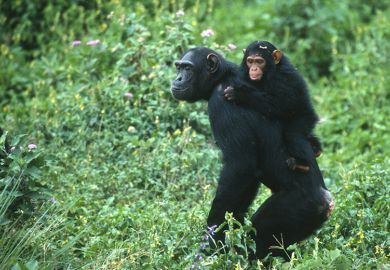In a biography-writing masterclass, I was once told that it was unwise to write an authorised biography of a living person; on every page the reader will feel the subject’s breath down the author’s neck. I think an exception can be made in cases where the “life” plays second fiddle to the “work”, and Lessons from the Lobster is a successful example of this.
The author, Charlotte Nassim, describes it as a “thought biography”, and it’s primarily about the progress of Eve Marder’s neuroscience, interwoven with biographical detail that’s relevant to the trajectory of her research. As Marder herself explains in the foreword, it was partly the promise of this scientific history approach that persuaded her to agree to the project, which draws extensively on her lab notes as well as interviews with her, her colleagues and students. The first time I read it, I couldn’t resist skating over the scientific detail to get at the human angle. My reread focused on the neuroscience, which is beautifully clear, with figures providing illuminating illustrations of Marder’s findings.
While Nassim is evidently full of admiration for Marder, the narrative feels objective and far from fawning. I have often felt that not enough credit is given to the role of luck in successful careers in science. So much can hinge on being in the right lab at the right time or on chance encounters. Thus I was delighted to see a paragraph devoted to a particular stroke of luck when Marder adopted the stomach nerves of a Pacific lobster – local to her PhD lab in San Diego – as her research model. “I am not suggesting that she would not have made an important contribution to biology under other circumstances,” writes Nassim, “but this was a marriage of scientist and model made in some sort of laboratory heaven.”
My initial encounter with crustaceans as model organisms came when I saw a gold crayfish lapel pin on the blazer collar of my first science boss, Darwin Prockop, collagen patriarch, born in 1929 and still running a lab today at Texas A&M University. Anyone who has worked on crustaceans, or bought them alive and tried to cook them, has tales of retaliation and escape, and the funniest bits of the book pertain to such episodes. Because Marder’s research generally uses only the stomach, she is constantly able to supply tasty lobster tails, we are told, “to foster good relations with colleagues, secretaries and friends”. Yet she herself doesn’t eat lobsters – “It would be like eating a colleague.”
Apparently, the lobster is akin to the scarecrow when it comes to brainpower and, according to Nassim, “exhibits intellectual pretension and achievement only in Wonderland”. As an enthusiast for all things Alice, this quote completely won me over, although both author and subject had already endeared themselves to me. While the lobster’s nervous system is simpler than its mammalian equivalent, Marder’s scientific output demonstrates the extent to which working on a well-defined model system of limited complexity can generate widely applicable insights. Nassim herself almost didn’t attend the Marder lecture that sparked this biographical project because, being a “mouse person”, she had little interest in lobster neural circuitry.
Successful scientists often possess, like the pop star Madonna, a capacity for reinvention. They shed their exoskeletons for growth and development and periodically adopt a new exterior. Marder is no exception: she has proved expert at exploiting new technologies. “Most heads of labs want to feel they are on top of the methods their teams are using,” writes Nassim, “but Marder has the confidence that she’ll learn enough to distinguish what she wants within the data.” As a mid‑career academic, I feel so swamped with administrative duties, funding applications and so on that the only way to confidently diversify is to work with collaborators and to hire people with different expertise. Marder’s own work and dynamic personality have attracted a wide range of researchers. When a former colleague visited her lab and chatted with a new physicist recruit, we read, “he said to Marder, ‘Where do you find these people?’ She said, ‘They find me’.”
While we are busy living life’s peaks and troughs, it’s difficult to gain any perspective on wider trends. Most of us will never have someone write an overview of our life, but we can learn lots from reading this one. I particularly loved watching Marder progress from postdoc in Paris to running her own lab. “The work I did there was not spectacular,” she reports, “but somehow the fact that I had been adventuresome enough convinced others I was ready to be independent.” Like Marder, I encourage scientists to move institutions as much as they can, more than anything to show that they are capable of fighting inertia. I equally enjoyed seeing how she transitioned from a close working relationship with her first PhD student to the more managerial role of a fully fledged lab head: “You’re the principal investigator, and you take on other responsibilities, and you’re only concerned with data – unless something goes wrong.” For me, this transition involved the greatest shift in my sense of identity. Suddenly your name is on lab equipment you’ve never seen – and sometimes the rest of the group goes to the pub without you.
Having recently received feedback on an unsuccessful but high-scoring grant application, that it was insufficiently “hypothesis-driven”, I welcomed this book’s constant refrain about the importance of data steering research. The opening quote from Sir Arthur Conan Doyle sets the scene: “It is a capital mistake to theorise before one has data. Insensibly one begins to twist facts to suit theories, instead of theories to suit facts.” Throughout the book, Marder extols the virtues of letting the experimental results speak. “I have a very, very, deep, abiding respect for actual data, whether it comes out of an animal or a computer model,” she says. There is an awe-inspiring anecdote in which Marder calls up an editor of the prestigious journal Science in 1990 to argue about her submission. “How can you conceivably reject an experimental paper because a model predicted the phenomenon?” she asks. These days, you probably couldn’t get a computer-generated model published anywhere good without experimental data to back it up, but her ideas were then so new that each step was a coup. This was one of those junctures in the book when I paused to remind myself not to succumb to romantic yearning for bygone times when it was possible, for example, to read the entire published literature about a topic.
In fact, the book’s longitudinal view, of a 40-year journey of discovery very obviously driven by the limitations and advances of technology, provides a clear lesson that scientists today must appreciate the incredible wealth of techniques that we now have at our fingertips. “When the time seemed right and the costs had shrunk,” Nassim tells us, “Marder bought the transcriptomes [complete list of RNA molecules] of Cancer borealis and Homarus americanus” – the kinds of crab and lobster on which her lab had been working for many years. Not only is it now possible to have the genome of an entire organism sequenced affordably and quickly, but there are numerous analytical methods for characterising and contrasting the contents of individual cells in situ. Marder is no stranger to information overload and excels in working out how to recognise meaningful conclusions within the scrum – an invaluable skill in today’s world.
Rivka Isaacson is senior lecturer in chemical biology at King’s College London.
Lessons from the Lobster: Eve Marder’s Work in Neuroscience
By Charlotte Nassim
MIT Press, 264pp, £22.00
ISBN 9780262037785
Published 13 July 2018
The author
Charlotte Nassim was born in London and spent her early years in England. She initially studied modern history and literature in Japan but, after being “seduced by Japanese architecture, both traditional and contemporary”, trained at the Architectural Association in London and spent 20 years as an architectural consultant for public arts buildings.
After getting tired of travelling, she decided to change track and “neuroscience seemed the subject least likely ever to be boring, so I took an Open University degree in biology with neuroscience, then a masters in integrative neuroscience at Imperial College London”. This led to a position at the Wolfson Institute for Biomedical Research at University College London, “investigating causes of neuron death in Alzheimer’s disease using mouse models”. Yet she became convinced that “trying to find a specific answer to a specific question in a crowded research field was not an intellectually satisfying endeavour. Also, by 2008, it seemed increasingly obvious that Alzheimer’s could not be usefully studied without taking inflammation into account, in which case the mouse, with a very different immune system to the human, was not the model of choice.”
The idea for her new book came to Nassim after she attended a lecture Eve Marder gave in London in 2006, when she was “stunned to learn several new basic facts about neurons – facts that weren’t in the textbooks and that contradicted the generally accepted science at the time. The research itself was relatively easy to understand and replicate, but Marder’s deductions from the data were brilliant, clear and seemed obvious as soon as you heard them, often a sign of really good science…
“I set out not so much to celebrate Marder, although my admiration for her grew as the work went on, as to find out how she turned her data into big ideas.”
Matthew Reisz
Register to continue
Why register?
- Registration is free and only takes a moment
- Once registered, you can read 3 articles a month
- Sign up for our newsletter
Subscribe
Or subscribe for unlimited access to:
- Unlimited access to news, views, insights & reviews
- Digital editions
- Digital access to THE’s university and college rankings analysis
Already registered or a current subscriber?







